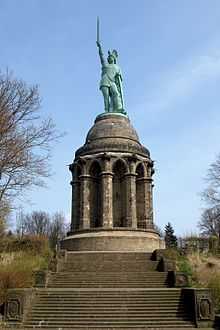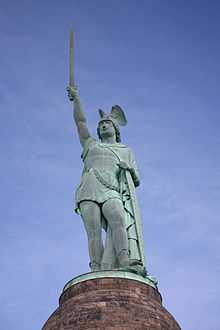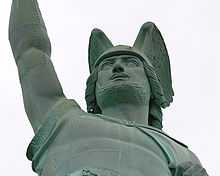Hermannsdenkmal
| Hermann Monument Hermannsdenkmal | |
|---|---|
 Hermannsdenkmal | |
| Coordinates | 51°54′42″N 08°50′22″E / 51.91167°N 8.83944°ECoordinates: 51°54′42″N 08°50′22″E / 51.91167°N 8.83944°E |
| Location | Teutoburger Wald, Nord Rhein-Westphalen, Germany |
| Designer | Ernst von Bandel |
| Type | Monument |
| Material | Sandstein auf Sockel |
| Height |
53.46 metres (175.4 ft) Socket: 26.89 metres (88.2 ft) Figure: 26.57 metres (87.2 ft) |
| Beginning date | 1838 |
| Completion date | 1875 |
| Opening date | 1875 |
| Dedicated to | Arminius (Hermann) |
The Hermannsdenkmal (German for Hermann monument) is a monument located in Ostwestfalen-Lippe in Germany in the Southern part of the Teutoburg Forest, which is southwest of Detmold in the district of Lippe. It stands on the densely forested and 386 m tall Grotenburg in the ring fortification located there. The hill is sometimes also called Teutberg or short Teut.
The monument commemorates the Cherusci war chief Hermann or Armin (Latin: Arminius) and the Battle of the Teutoburg Forest in which the Germanic tribes under Arminius recorded a decisive victory in 9 AD over three Roman legions under Varus. On that occasion, the Roman commander was tricked by Hermann, who attracted the legions in a colossal well-prepared ambush. At the time it was built, the location of the statue was believed to have been very near the actual site of the battle, though it is now known through excavations that the battle actually happened near Kalkriese, a considerable distance to the west and north of the monument.
The sword has the following inscription:
DEUTSCHE:EINIGKEIT:MEINE:STÄRKE
MEINE:STÄRKE:DEUTSCHLANDS:MACHT
- German unity (is) my strength - my strength (is) Germany's might.
History

Construction for the 53.46 m (173.39 ft) tall statue was started in 1841, but not completed until 1875 with the help of substantial funds from the state of Prussia. It was built according to plans by the sculptor Ernst von Bandel.
Under the impression of the repeated defeats at the hands of the French and the fractured nature of the German states, Germans began to orient themselves toward the ancient past as a source of national pride. This search for identity is exemplified in several national memorials including the Walhalla temple near Regensburg and the Statue of Arminius.
However, the statue was not completed until after the Franco-Prussian War of 1870-1871, and the unification of most of Germany in 1870 under Bismarck.
Tourism

The statue is one of the most popular tourist destinations in Germany with over 130,000 visitors a year. Of similar popularity are the Externsteine, which are located nearby. The statue's base may be climbed up to a level before the figure starts, affording wide landscape views.
A similar Hermann Heights Monument exists in New Ulm, Minnesota, a town settled by German immigrants. The term "Herman the German" is also commonly used by English speakers as an affectionate name for the Hermannsdenkmal - and also as a jocular term for (male) Germans in general.
See also
| Wikimedia Commons has media related to Hermannsdenkmal. |
- Walhalla temple (Hall of the Slain, Regensburg, Germany)
- Ruhmeshalle (Hall of Fame, Munich, Germany)
- Befreiungshalle (Hall of Liberation, Kelheim, Germany)
- Heldenberg Memorial (in Austria)
- Hermann Heights Monument (in New Ulm, Minnesota)
- List of statues by height